Midrange CPU Roundup: It's Time to Buy
by Anand Lal Shimpi on September 28, 2007 2:00 AM EST- Posted in
- CPUs
General Performance
SYSMark 2007 takes 14 current desktop applications and runs groups of them through four different scenarios categorized by BAPCo as E-Learning, Video Creation, Productivity, and 3D.
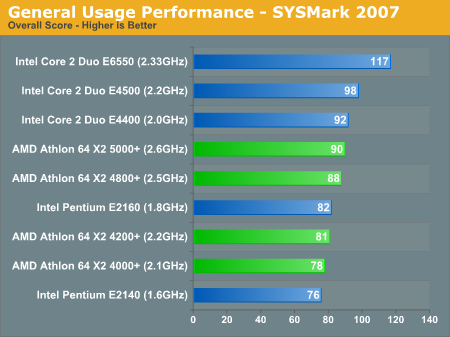
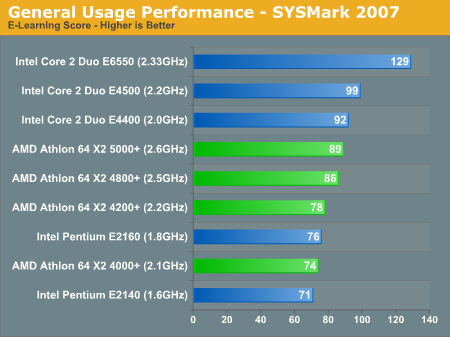
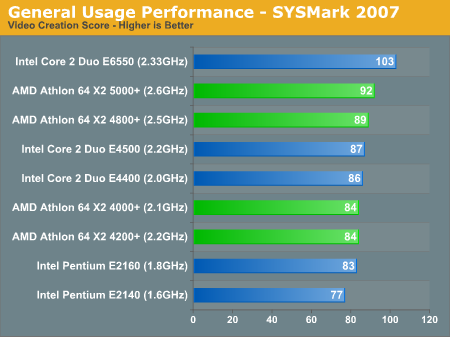
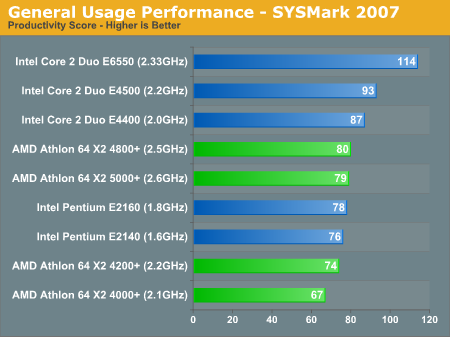
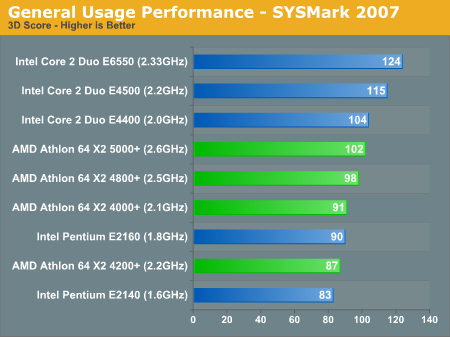
Overall performance is slightly in Intel's favor when we look at the matchups we outlined at the beginning of the article. The Core 2 Duo E4500 is slightly faster than the Athlon 64 X2 5000+, but the margin of victory shrinks considerably when we look at the E4400 vs. Athlon 64 X2 4800+. The difference between the E4500 and E4400 is 200MHz, or about 10%, while the difference between the 5000+ and 4800+ is only 100MHz and less than 4% of the clock speed of the 5000+, resulting in a narrowing gap as we head down in price on Intel's side. For all intents and purposes, the Core 2 Duo E4400 is the same speed as the Athlon 64 X2 4800+, and on the AMD side there's no real reason to purchase the 5000+ as it doesn't really offer a tangible performance advantage over the slightly cheaper 4800+.
The race is also close at the very low end. The Athlon 64 X2 4000+ (and X2 BE-2350) is very close to the Pentium E2160 in performance, although Intel gets the slight edge. Unlike competition at the higher end of the CPU spectrum, AMD and Intel are neck and neck with their mainstream CPUs in general usage.
SYSMark 2007 takes 14 current desktop applications and runs groups of them through four different scenarios categorized by BAPCo as E-Learning, Video Creation, Productivity, and 3D.





Overall performance is slightly in Intel's favor when we look at the matchups we outlined at the beginning of the article. The Core 2 Duo E4500 is slightly faster than the Athlon 64 X2 5000+, but the margin of victory shrinks considerably when we look at the E4400 vs. Athlon 64 X2 4800+. The difference between the E4500 and E4400 is 200MHz, or about 10%, while the difference between the 5000+ and 4800+ is only 100MHz and less than 4% of the clock speed of the 5000+, resulting in a narrowing gap as we head down in price on Intel's side. For all intents and purposes, the Core 2 Duo E4400 is the same speed as the Athlon 64 X2 4800+, and on the AMD side there's no real reason to purchase the 5000+ as it doesn't really offer a tangible performance advantage over the slightly cheaper 4800+.
The race is also close at the very low end. The Athlon 64 X2 4000+ (and X2 BE-2350) is very close to the Pentium E2160 in performance, although Intel gets the slight edge. Unlike competition at the higher end of the CPU spectrum, AMD and Intel are neck and neck with their mainstream CPUs in general usage.










44 Comments
View All Comments
wdb1966 - Monday, October 1, 2007 - link
Wow, very mature response.BTW, I'm an Intel user with a pair of Q6600 rigs as well as an older 939 rig.
I stand by my comments, Anand got the pricing and hardware wrong, period.
AkumaX - Friday, September 28, 2007 - link
are there any good intel matx mobos with hdmi (or integrated gfx?)that's the only reason why i would consider going with AMD, because cpu performance doesn't make that much of a big deal to me, but having onboard hdmi would (and a better integrated chipset overall)
ltcommanderdata - Friday, September 28, 2007 - link
Can we please get a review of the 14.31.1 XP driver for the GMA X3000 that enables hardware DX9.0c SM3.0 acceleration? I know you've switched over to Vista, but the 15.6 driver release notes don't mention that they added hardware acceleration so it looks like only the 14.31 and the newer 14.31.1 XP drivers have it. I would love to see a comparison between the GMA X3000, Xpress X1250, Geforce 7150, and a discrete X1300HM and 8500GT.You're probably saving the new drivers for an IGP review when the G35 GMA X3500 comes out (October 21?), but it would be nice to have numbers for the GMA X3000 too for comparison.
Leinad - Friday, September 28, 2007 - link
Would be wonderful to have a MB roundup to go along with a processor roundup.Please?
yyrkoon - Friday, September 28, 2007 - link
I feel that the mothernoards you used for your tests were not up to the task. Earlier this year, I went out on a limb(for my personal standards) in buying a very in-expencive motherboard in hopes of saving $20-$30 usd on my system costs. While I did not experience any of the issues you mention having with the Geforce 6000 chipset that you mentioned here, I found this board to be completely un-exceptable stability wise. Every 3-5 days, the system would lock up, or BSoD(and sometimes much sooner). This system board did not have any memory voltage adjustment settings what-so-ever, and this was probably a big part as why the motherboard would not run smoothly(the board defaulted my memory lower than it should have been). Overclocking this system board also proved to be fruitless, even though there were enough options(short of the memory voltage settings) to do so. This motherboard was also plauged by other problems, one of which where talking to the 'tech' staff at the manufactuer proved that I was obviously more knowledgable concerning their own hardware, and every other set of words out of this 'techs' mouth seemed to be 'This is a budget motherboard'. This is the responce I got even when asking for an updated BIOS link, and to this day, the BIOS for that board has never been updated.
On the flip side, I purchased a similar board from a company that I trust, and have been dealing with for many years. This board was based on the 6150 chipset, has voltage settings for memory, and will easily overclock my AM2 1210 opteron to 3.0 Ghz(base frequency is 1.8Ghz). At current, the BIOS for this board has been revised 3-4 times, and while the motherboard has been phased out for a few months now, I suspect that the BIOS revisions will keep on comming based on past experiences with this company. This board has been very stable, with only a handful of BSoDs because of overclocking too high on the stock cooler, or a few other software related glitches. All while running WinXP Pro 32BIT with the /PAE boot option enabled. Also, since this motherboard OEM has a top notch Forum, and I have found this board to be virtualy trouble free(but not perfect), I have had no reason to even bother their tech representatives.
These two different motherboards both used the same exact hardware on them, and the second one will work perfectly fine with Windows 2003, where as the first will not(no networking drivers).
Leaving the two company names out of it, the moral of the story is; I had hoped to save myself $20-$30 usd, and it ended up costing me another $75 usd in the long run.
Now naming names, the first board was an Asrock AM2NF-4G-SATA2, and the second board was an ABIT NF-M2 nView. Since I have named names yet again, I suspect a few 'Fan-boi' comments, but this is not about Fan-boi-ism; this is about an experience out of many similar in dealing with different companies over the past 13 years when purchasing parts for systems. Top Tier manufactuers are top tier for a reason . . . and trust me, I would rather pay less for another brand, for the same performance/stability, but it has been this users experiences(many times . . .) that I will be let down, and end up paying more in the long run to correct issues for sub standard parts/service.
Myrandex - Friday, September 28, 2007 - link
I have sold many GeForce6150 based computers to people without a problem at all. I have not tried to overclock them, but from what I understand I hear that they perform better than the 70xx series of integrated GPU's (I could be remembering wrong). I have had some sweet Winfast Foxconn boards with Nvidia 6150 chipsets, but also that new AMD chipset is pretty good.strikeback03 - Friday, September 28, 2007 - link
We needed new workstations earlier this year for a couple of students, so I built 2 computers using really cheap components. Used ECS motherboards (nVidia 6100 chipset) with some cheap X2 processors and a GB of Corsair ValuRam, powered by a power supply included in a cheap Rosewill case. No overclocking (obviously) but everything has been stable so far.yyrkoon - Friday, September 28, 2007 - link
I have built quite a few systems for customers using ECS motherboards. Have also replaced a few motherboard from eMachines, and whatnot with ECS motherboards. They all seem to work fine, as I have had zero complaints so far.In my own personal machines however, I may require extra features that the average user may not, and my most recent personal purchase has exactly what I want, for a fair price, and stability second to none.
Having said that, we here also avoid Asus motherboards like the plauge, as we have had bad experiences with their boards, with the most 4 recent boards made by them showing up DOA here in our shop. Obviously, I do realize since Asus seems to be a trend among the younger users I've seen post around, that I do not think they do not work all the time; this is just our experiences here.
I really do not respect DFI, BIOSTAR, like other brands such as ABIT, Gigabyte, and MSI(for Intel based systems) though. But if a customer wants a 'cheap' PC, thats what they get . . . and we usually recommend Dell in this case anyhow.
leexgx - Friday, September 28, 2007 - link
little picky on nvidia's driversnvida chip set drivers are updated every year (thay never seem to bother to update them) so there chipset drivers will not allways have the Nvidia display drivers and even if it did the first thing i do any way is get the new video drivers as well and install them after chpset drivers no problem
ThatLukeGuy - Friday, September 28, 2007 - link
Just wondering about this part of the article:"We'd take the slowest Pentium Dual Core over the fastest available Pentium D, so stay away from the last remnants of the NetBurst architecture if you know what's best for you."
I bought a Pentium D 805 Smithfield 2.66GHz LGA 775 Processor a while ago as a stopgap for my new rig. Basically it was so I could use the system which had a 775 and wouldn't take my old P4, looking to upgrade to a Core 2 at the earliest opportunity. I found on the internet some information however that the Pentium D 805 was a diamond in the rough and could be easily overclocked to rival performance with some of Intel's extreme chips. Sure enough I got it to goto 3.2GHz without even changing anything but the FSB. Same cooling solution, same everything and the system is rock solid and pretty darn fast. Thus I decided to just stick with the Pentium D. Was I wrong to stay with it? Is going to the slowest Core 2 better than the setup I have now? Not trying to get in an argument, I'm honestly curious if I made a misjudgement and what the reasons for the slowest Core 2 being better than a Pentium D @ 3.2GHz (with supposed potential up to 3.6GHz or higher) are.